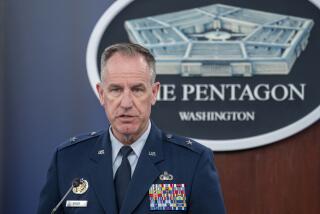U.S. Reveals Chemical Arms Plant Sites : Calls on Soviets, Others to Follow Suit in Effort to Ban Weapons
- Share via
GENEVA — The United States, calling its action “unprecedented,” disclosed Thursday the exact number and location of its chemical weapons factories.
Max L. Friedersdorf, U.S. delegate to the 40-nation Disarmament Conference here, urged the Soviet Union and other countries to make similar declarations to accelerate negotiation of a global ban on chemical arms.
A chemical weapons treaty has been held up during 12 years of talks at the multilateral disarmament forum because of problems in verifying stockpiles and monitoring their destruction along with production facilities.
The use of chemical arms is forbidden under a 1924 international convention. The Geneva conference has been seeking to extend the ban to production, deployment and stockpiling of such weapons. The issue has become more urgent in the wake of U.N. reports confirming the use of poison gas in the Persian Gulf War between Iran and Iraq.
On Thursday, the United States presented the conference with a map showing the location of its five production plants, details of what lethal toxins are made at each facility and proposing methods of destruction.
Plants identified were at Rocky Mountain Arsenal in Colorado, Newport Army Ammunition Plant in Indiana, Pine Bluff Arsenal in Arkansas, Muscle Shoals in Alabama and Aberdeen Proving Ground in Maryland.
Soviet chief delegate Yuri K. Nazarkin called the U.S. statement interesting and said he will study it.
Friedersdorf told the Disarmament Conference--established in 1962 and reporting to the U.N. General Assembly--that the U.S. move was a “major step towards openness.”
“The declaration is unprecedented,” he said. “No other member of the conference has provided information on its chemical weapons production facilities.
“We urge other countries . . . to declare the location of their facilities and to outline how the facilities would be destroyed,” he said.
Storage Depots Shown
The United States in 1986 disclosed the sites of its chemical weapons storage depots and followed up in April this year with detailed information on the weapons themselves.
Last year, the Soviet Union officially admitted to possessing chemical arms, and it allowed representatives from 45 nations, including the United States, to visit a military chemical weapons complex in the Volga River region, 90 miles north of Sartov.
Friedersdorf said about 12 members of the conference have as yet failed to even “indicate” whether or not they possess such weapons.
“Inaccurate declarations will decrease confidence and complicate efforts to ban chemical weapons,” Friedersdorf said. “Truthful declarations are essential to the entire process.”
He also said that while progress on a treaty is being made, there remain problems such as protecting industrial secrets when civilian chemical factories are checked to make sure they are not making weapons as well.
A chemical weapons ban must also be universal, Friedersdorf said, because recent years “make clear that the greatest risk of their use lies outside Europe--as demonstrated in the Middle East.”
In its declaration Thursday, the United States proposed technical methods of destroying chemical weapons plants and stockpiled arms, saying “physical destruction of all standard and specialized equipment and buildings must ensure that the components cannot be reassembled.”
Destruction of the facilities should be verified by means of on-site international inspection, the United States said.
More to Read
Sign up for Essential California
The most important California stories and recommendations in your inbox every morning.
You may occasionally receive promotional content from the Los Angeles Times.










